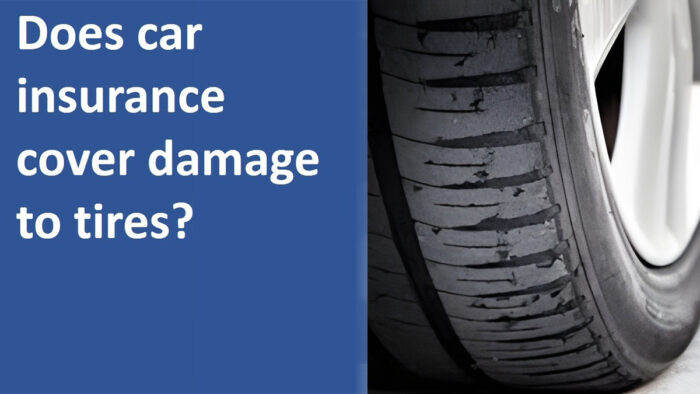Car insurance coverage for tire damage can be a complex topic, as it depends on the specific circumstances and the type of insurance coverage you have. Comprehensive and collision coverage are the most common types of insurance that can cover tire damage to your car. If you have these coverages, your car insurance may help cover the cost of repair or replacement if your tires are damaged by a covered peril, such as vandalism, theft, or damage from potholes.

However, insurance typically does not cover wear-and-tear issues like flat tires due to normal usage or road hazards.If your tires are damaged in an accident, your collision coverage may help cover the cost of repair or replacement. If your tires are damaged by a covered peril, such as vandalism or a pothole, your comprehensive coverage may help cover the cost of repair or replacement.
In these cases, it’s important to note that filing a claim for tire damage may not always be beneficial if the repair costs are lower than your deductible amount. In such cases, it might be more cost-effective to pay for the damage out of pocket to avoid potential premium increases.
It’s essential to review your insurance policy carefully to understand the specifics of your coverage and to consult with your insurance agent if you have any questions or concerns about tire damage coverage.
Does Car Insurance Cover Slashed Tires?
If your tire incur intentional damage, comprehensive coverage within your car insurance policy can cover the cost of repairing or replacing them. Typically, filing a police report is necessary to process such a claim. Comprehensive coverage extends beyond slashed tires to include coverage for various forms of vandalism like broken windows, keying, or spray-painting on your vehicle.
Consumer Reports notes that tire replacement costs can range from $130 to $190, varying based on your vehicle type. If the replacement cost is lower than your deductible, it may be more cost-effective to cover the expense yourself to avoid potential rate increases from filing a claim.
Does Car Insurance Provide Coverage for Stolen Tires?
If your tires are stolen, comprehensive coverage in your auto insurance policy can provide coverage for their replacement. Typically, filing a police report is necessary to process such a claim. Comprehensive coverage extends to replacing stolen car parts and even covers the theft of your entire vehicle. However, it does not extend to personal items stolen from your car, such as a backpack or phone.
Does Car Insurance Provide Coverage for Tire Damage Caused by Potholes?
Pothole-related damage may fall under collision coverage, which typically handles damage resulting from collisions with objects or vehicles. If your vehicle sustains damage from hitting a significant pothole, collision coverage could cover expenses like a shredded tire, a dented rim, or wheel misalignment.
The cost of replacing a dented rim can vary from $50 to over $500, while the cost of repairing a misalignment may range from $80 to $100. If the total repair costs are lower than your deductible, it might be more cost-effective to cover the expenses yourself rather than filing a claim.
Does Car Insurance Cover Flat Tires?
Coverage for flat tires can vary among insurance providers. Typically, flat tires are viewed as a result of wear-and-tear, which is not covered by car insurance since it excludes routine maintenance. However, if your flat tire is due to running over road debris like glass, your insurance might cover the damage.
In situations where you experience a flat tire and are stranded, roadside assistance can be utilized to have a new tire installed, although you may be responsible for the cost of the tire itself.
Does Car Insurance Include Coverage for Tire Rotation?
Generally, car insurance does not cover tire rotation as it falls under routine maintenance. Tire rotation is recommended by some experts every 5,000 to 8,000 miles to ensure even tire wear, especially since front tires typically bear more braking stress. Fortunately, the cost of a tire rotation is usually under $60.
How Frequently Should I Change My Tires?
Manufacturers typically suggest replacing tires every six to ten years, as advised by the National Highway Traffic Safety Administration. An easy way to determine if your tires need replacement is by conducting the “penny test.” Simply insert a penny into the tire tread with Lincoln’s head facing down. If the top of Lincoln’s head is visible, it indicates the need for tire replacement. If part of his head is covered by the tread, you can delay replacing your tires.
Should I Get Insurance for My Tires?
Whether to get insurance for your tires depends on your specific needs and the coverage provided by your existing car insurance policy. Car insurance typically covers tire damage if you have comprehensive and collision coverage included in your policy.
This coverage extends to scenarios like vandalism, theft, or damage from potholes. However, insurance generally does not cover wear-and-tear issues like flat tires due to normal usage or damage from road hazards.
If your tires are damaged in an accident, your collision coverage may help cover the cost of repair or replacement. If your tires are damaged by a covered peril, such as vandalism or a pothole, your comprehensive coverage may help cover the cost of repair or replacement.
In these cases, it’s important to note that filing a claim for tire damage may not always be beneficial if the repair costs are lower than your deductible amount. In such cases, it might be more cost-effective to pay for the damage out of pocket to avoid potential premium increases.
It’s essential to review your insurance policy carefully to understand the specifics of your coverage and to consult with your insurance agent if you have any questions or concerns about tire damage coverage.
How to File a Car Insurance Claim for Tires
To file a car insurance claim for tire damage, follow these steps:
- Review your policy: Check if you have comprehensive coverage, as it typically covers slashed tires, theft, and damage from covered perils like potholes.
- Document the damage: Take photos of the damaged tires and any relevant details to support your claim.
- Contact your insurance company: Notify your insurer about the tire damage and provide all necessary information, including photos and a description of how the damage occurred.
- File a claim: Follow your insurance company’s procedures for filing a claim. Provide details about the incident, such as when and where it happened.
- Assessment: An adjuster may inspect the damage to assess the extent and validity of the claim.
- Repair or replacement: If your claim is approved, your insurance may cover the cost of repairing or replacing the damaged tires, depending on your coverage and deductible.
- Consider costs: Evaluate if filing a claim is worthwhile based on repair costs compared to your deductible amount. If the repair costs are lower than your deductible, it may be more cost-effective to pay out of pocket.
By following these steps and understanding your coverage, you can effectively file a car insurance claim for tire damage and ensure a smooth claims process.
FAQs
Does car insurance cover flat tires?
Car insurance may cover flat tires if they are caused by a covered peril, such as vandalism, or if you have roadside assistance.
Does car insurance cover tire damage from potholes?
Damage from potholes could be covered by collision coverage, which covers damage to your car from a collision with another vehicle or object.
Does car insurance cover wear and tear on tires?
No, car insurance does not cover general wear and tear, including any regular and necessary maintenance.
What is the deductible for tire damage claims?
The deductible for tire damage claims depends on the specific coverage and policy. It’s important to review your insurance policy and consult with your insurance agent to understand the deductible for your tire damage coverage.
How can I protect my tires over time?
To protect your tires over time, consider regularly inspecting them for damage, rotating them every 6,000 to 8,000 miles, and storing them properly if you need to store them for an extended period of time.



